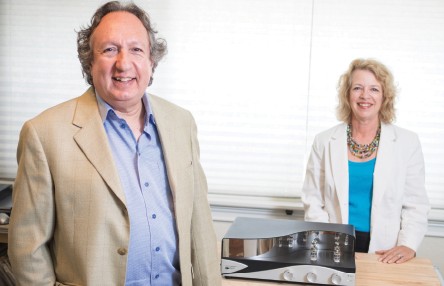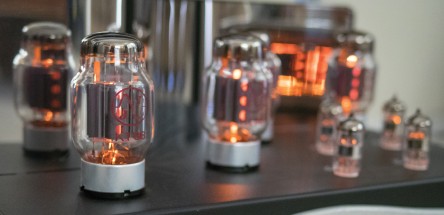
Zesto Audio owners George and Carolyn Counnas with their Leto pre-amplifier.
SPIRIT OF SMALL BUSINESS | July 25-31, 2014
By Stephen Nellis
Staff Writer
In just a few short years, Thousand Oaks-based Zesto Audio has gone from the drawing board to heard around the world.
Founded by George and Carolyn Counnas, Zesto makes high-end audio gear. Its products are aimed at so-called “audiophiles,” discerning listeners who often spend well into six figures on a playback system and for whom vinyl records and non-digital electronics represent the gold standard for quality.
The couple started Zesto in 2011, and the company has racked up a pile of awards from audio magazines and editors for the three products it has released so far. Those reviews are being read around the world. The young company now sells most of its products, which are built by hand in Ventura County, internationally.
“We just shipped five boxes to Taiwan last week,” said George, noting that a dealer there had heard about Zesto’s products from an existing dealer in Hong Kong.
“They love U.S. audio. They don’t want to buy Chinese audio,” Carolyn said.
George had a long career in professional audio. Listening to great musicians was a pleasure, but many paying studio customers fell considerably short of greatness. Making a living from sound had brought George “to the point where I couldn’t listen to music any more.”
When George was laid off, he found he could appreciate music once again. He volunteered to help a friend with stereo equipment and built a phono stage, the first piece of gear that the sound signal hits after coming from the turntable. “I realized it would be interesting to build something — I wasn’t hearing anything that I liked,” George said.
George set about designing new products with old technology — vaccum tubes and analog components. Transistors and digital parts might be smaller and less power hungry, but the older technology provides a sound like no other.
“Tubes are faster, and they have a sonic signature that’s unique,” George said. “When I went to college, it was just as they were starting to transition from tubes to solid state. I retained some of that knowledge.”

Bia 120 power amplifier
Of course, the engineers who designed the first high-fidelity audio circuits in the 1930s used slide rules, and Counnas can use a computer. Modeling software helps him go through scores of revisions on each product quickly. But for the final analysis, George relies on his ears. After “tens of thousands of paid hours in the studio … your hearing gets refined,” he said.
Zesto’s products have gained a reputation among reviewers for providing the warmth and fullness associated with tubes without overtly “coloring” the sound.
“What I was hearing was that most hi-fi equipment was designed to color the material a certain way. You can’t build a system without color, but I wasn’t hearing a neutral,” George said.
Editors have declared the efforts a success, giving Zesto multiple awards. Robert H. Levi of Positive Feedback magazine called Zesto’s power amplifier “the most neutral tube amp ever created.”
Paul Seydor of The Absolute Sound called the company’s preamplifier “magical,” noting that it was somehow neutral without being sterile. “Whatever the explanation, it results in a musicality and an impression of realism that are at once valid and authoritative yet without ever stepping outside the boundaries of sonic neutrality,” he wrote.
Audiophiles often fixate on technical specifications. They focus less on how an object looks, but Zesto’s founders believed the look of the gear was as important as its sound. Carolyn, an artist whose canvases decorate the couple’s home, designed Zesto’s enclosures. They feature glossy black curves that recall a grand piano and mirror-polished surfaces behind the tubes to reflect their orange glow. “I felt there was a huge dissonance between the aesthetic of the equipment and the beauty of the music,” Carolyn said. “High-end audio was always, ‘What’s with this black box thing?’ ”
George added, “If someone is going to bring something into a home, it needs to have a high ‘wife acceptance factor.’ ”
Combined, Zesto’s three products — a phono stage, a pre-amplifier and a power amplifier — retail for a little more than $24,000. In the world of high-end audio, however, Zesto has come to stand for a great value for the money, with reviewers commenting that it competes well with gear costing twice as much or more.
Zesto is working on getting the necessary certifications to sell in the European Union. Certification is costly for a small, self-funded company that has relied on organic growth. But dealers there are asking about the products, and Zesto has finally built enough of a following to take the plunge.
“We want to do everything — every business does — but I’m so glad it’s been organic,” Carolyn said. “It makes you make better decisions.”
Zesto plans new products in the future. And longer term, vinyl records are on the upswing, and even the iTunes generation is gravitating toward better headphones. George and Carolyn are convinced that when today’s younger generation grows up, they’ll one day want the kind of listening experience only a high-end audio system can provide.
“There’s an entire generation that’s not heard good music. But there’s something about being human that loves music. You can tell the difference between an earbud and a symphony,” Carolyn said.


